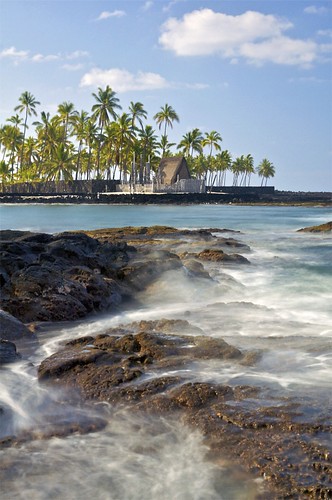Ancient Hawaiian society was governed by a multitude of sacred laws, or kapu. Some of these laws stated that commoners could not look at their chieftains or even let their shadows fall on royal ground, that men and women could not eat together, that certain fish were only to be caught by royalty, and that women could not eat bananas. If a person failed to keep any one of the kapu, the gods would become angry and the offender would face certain death – unless he or she could escape to a place of refuge, such as the one at Pu’uhonua o Honaunau. Once inside the walls of the sacred city, the lawbreaker could then be absolved by a priest and was free to return home.
Today, a sense of peace surrounds this historic site, still considered a sacred place to many Hawaiians. Located south of Kona on the Big Island’s western shore, this National Park offers visitors and locals alike a chance to step into Hawaii’s past. On your self-guided, ranger-led, or audio tour of the area, you will see traditional thatched roof houses, carved wooden statues of the Hawaiian deities, palm-lined fishponds, and the Great Wall, which is built of stones without mortar and stretches 1000 feet long, 10 feet high and 17 feet thick! The park also has cultural demonstrations on traditional weaving, fishing, carving, and games, as well as various festivals throughout the year. A short hike away, you can visit Ki’ilae Village, which features ruins of ancient homes and temples, animal pens, salt vats, coconut groves, and a lava tube. Most days at Pu’uhonua o Honaunau, you will see honu (green sea turtles) lounging on the shore, and those who wish to snorkel will absolutely love nearby Two Steps Beach, which is teeming with fish, corals, honu, and even spinner dolphins!

